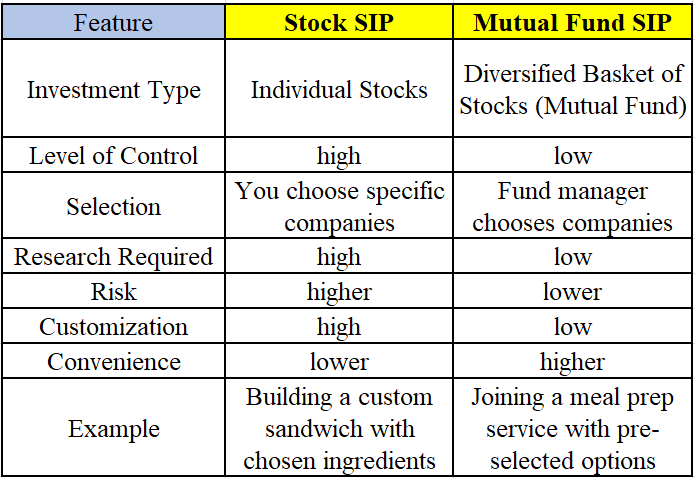Stock SIP vs Mutual Fund SIP
Picture this: you want a pizza for dinner. And you love pepperoni as a topping, but imagine if all your slices had only that as a topping? Perhaps tasty, but a really tasty pizza has not one but several other toppings, for instance, peppers, onions, and perhaps even pineapple. Now, don’t come at us for mentioning pineapple. Similarly, investing can be like building your financial pizza. You want some delicious high-growth potential and a base of stability to avoid ending up with a burnt crust (losing all your money!).
This is where Stock SIPs and Mutual Fund SIPs come in. Both are ways to invest regularly, like adding toppings to your pizza bit by bit. But they differ in how they handle the “topping selection.” Let’s dive in and see which one suits your financial taste buds!
What is a Mutual Fund SIP?
Imagine a fun pizza party where everyone contributes to create a delicious masterpiece. A mutual fund SIP works similarly. You contribute a fixed amount of money regularly, like your monthly pizza fund dues. But instead of buying individual slices (stocks), you invest in a pre-made pizza (diversified portfolio) managed by a professional chef (fund manager). This chef uses your contributions, along with others, to buy a variety of toppings (different stocks across various industries). The result? A well-rounded pizza that everyone enjoys is similar to how your investment is spread out across multiple companies to reduce risk.
This crowd-funding approach to investing offers several benefits. One major perk is diversification. Just like everyone enjoys a variety of flavours at the pizza party, your investment isn’t dependent on the performance of any single company. The fund manager, like your skilled chef, selects the toppings (stocks) and ensures a balanced investment pie. Finally, SIPs automate your contributions, letting you focus on the party (your financial goals) without worrying about picking the perfect toppings every month. Mutual Fund SIPs are a convenient and well-rounded way to invest for long-term goals, offering a balance between risk and reward.
What is Stock SIP?
Craving a delicious sandwich but tired of the same old cafe options? A Stock SIP lets you become the sandwich artist of your investment portfolio. It stands for Systematic Investment Plan (SIP) in Stocks. Here’s how it works:
Imagine planning to regularly invest a fixed amount, like your weekly lunch budget. With a Stock SIP, you use this money instead of grabbing a pre-made sandwich to buy the ingredients like stocks in the market for your financial masterpiece. The beauty? You can handpick the companies you believe in, like choosing your favourite meats, cheeses, and veggies. This allows you to craft a customized portfolio that reflects your investment goals and risk tolerance.
However, unlike a pre-made sandwich, building your own requires more effort. You must research different companies and select the ones that fit your investment recipe. Additionally, the price of these ingredients, that is, the stocks, can fluctuate, like vegetables going on sale or your favourite cheese getting a bit pricier. This means there’s a chance your investment sandwich might not turn out exactly as planned, similar to picking toppings that clash in flavour or even spoil if not chosen carefully.
STOCK SIP VS MUTUAL FUNDS SIP

Why is SIP in mutual funds an intelligent move?
Making regular investments through a SIP (Systematic Investment Plan) in Mutual Funds can be a smart financial move for several reasons:
- Build Discipline: SIPs automate your savings, like setting up a recurring bank deposit. This removes the temptation to spend and ensures you invest consistently, even when the market seems shaky. Imagine trying to stick to a gym routine – sometimes motivation withers. SIPs act like your gym buddy, holding you accountable and helping you build a regular investing habit.
- Diversification Matters: Unlike putting all your eggs in one basket, Mutual Funds hold various stocks across different companies and industries. Imagine only investing in a single bakery – if they have a bad batch of cookies, your entire investment might suffer! Thus, with diversification under Mutual Funds, one is able to spread out risk. And if one company within the fund has underperformed overall, the appreciation of the other companies cuts down on the damage.
- Expert Help on Board: Mutual Funds are operated by experienced fund managers who conduct research on a particular stock and its market before investing it in the Mutual Fund. In a way, it is like having a fund manager on your side, watching the market closely and making the right move. It saves time or even the need to become a stock-picking guru in a bid to get the best results. Visualize driving through a complicated city. Having a good GPS assists the driver in getting to the intended place. Similarly, the fund managers work for you and help navigate your investments in the direction of potential gains.
- Compounding Power: Reinvesting your earnings can significantly boost your returns. Think of a snowball rolling downhill – it starts small but gathers momentum as it goes. Compounding is similar – your returns start small but grow exponentially over the long term. SIPs make this process automatic, constantly adding fuel to your investment snowball.
Why Should One Choose Stock SIP?
Regular investing through a Stock SIP can be a powerful tool for growing your wealth, but it requires a different approach compared to Mutual Fund SIPs. Here’s why:
- Brick by Brick: Stock SIPs allow you to invest a fixed amount in specific stocks at regular intervals, like buying bricks to build a house. Over time, you accumulate more shares, potentially benefiting from the company’s growth.
- Targeting Your Wins: Unlike a pre-built house (Mutual Fund), you choose the individual stocks you invest in. This allows you to target companies you believe have strong growth potential, potentially leading to higher returns if your picks perform well. But remember, just like a poorly built house can crumble, choosing the wrong stocks can lead to losses.
- Do Your Own Renovations:Unlike having a contractor manage your house similar to fund manager managing your mutual funds, Stock SIPs require more research and effort. You’ll need to understand the companies you invest in and monitor their performance. Think of it as learning to do your own renovations – it takes time and effort, but you have more control over the final outcome.
- Patience is Key: Stock markets can be volatile in the short term, but Stock SIPs encourage a long-term perspective. Just like building a house takes time, wealth creation through stocks also requires patience. SIPs help you ride out market ups and downs, potentially averaging out the cost per share and benefiting from long-term growth.
Remember: Stock SIPs offer potentially higher rewards but also carry greater risk compared to Mutual Fund SIPs. Choose this route if you’re comfortable with research and a longer-term investment horizon.
Ending Note!
So, which SIP is the better choice: SIP in Mutual Funds or Stocks? The matter is not very clear and simple, as there is no template to follow.
A Stock SIP could be suitable for you if you are a seasoned investor and relish the idea of directly selecting stocks. However, if you are a novice, or if you simply do not have the time and/or inclination to devote to diligently picking stocks, a Mutual Fund SIP may well be ideal for you. In conclusion, any SIP is a good SIP if it suits your financial profile and meets your needs. The important thing is to begin investing! SIPs, therefore, have the advantage of enabling you to consistently invest a small portion of money towards the investment of your choice, which can, in the long run accumulate a huge amount of money in your investment account. Take your time, investigate and learn about the principles of the options available, and go for whichever type of SIP you feel you are comfortable with and your kind of investment strategy.
Happy investing!
Please share your thoughts on this post by leaving a reply in the comments section.
Also, check out our recent post Best Mutual Funds to Invest in 2025 & Best SIP Plans to Invest .
Contact us via Phone, WhatsApp, or Email to learn more about mutual funds, or visit our website. Additionally, you can download the Prodigy Pro app to start investing today!
Disclaimer – This article is for educational purposes only and by no means intends to substitute expert guidance. Mutual fund investments are subject to market risks. Please read all scheme-related documents carefully before investing.

Assistant Vice President – Research & Analysis
Akash Gupta heads the Research & Analysis department at BFC CAPITAL, where he combines in-depth market insights with strategic analysis. He holds multiple certifications, including:
- NISM-Series-XIII: Common Derivatives Certification
- NISM-Series-VIII: Equity Derivatives Certification
- NISM-Series-XXI-A: Portfolio Management Services Certification
- IRDAI Certification
With his expertise in equity, derivatives, and portfolio management, Akash plays a key role in providing research-backed strategies and actionable insights to help clients navigate the investment landscape.








